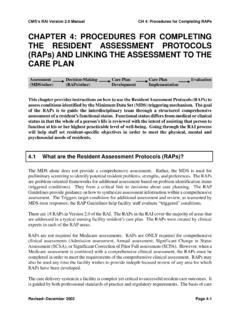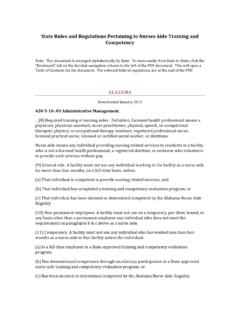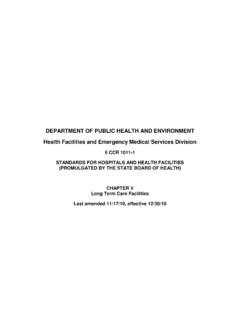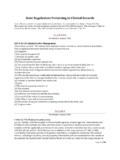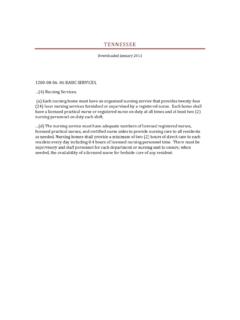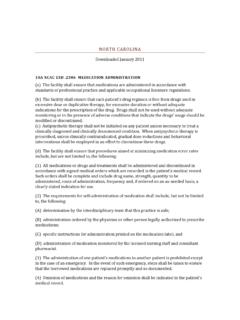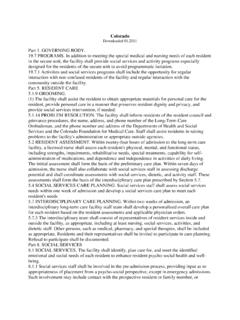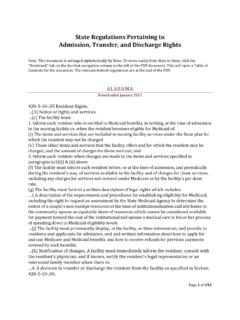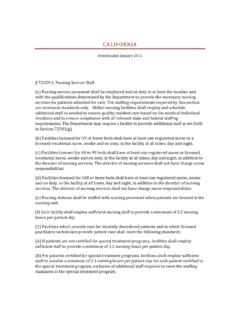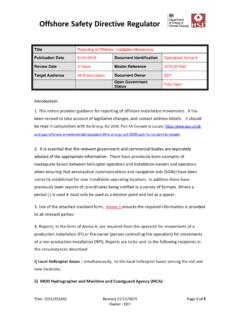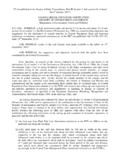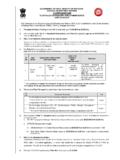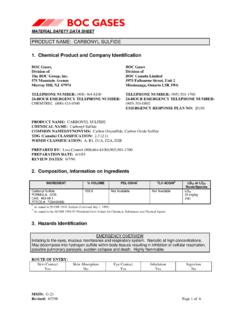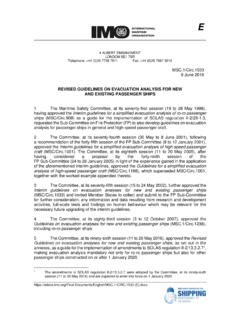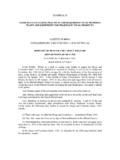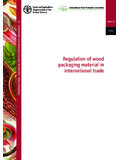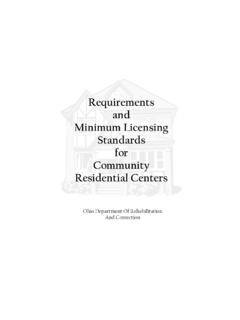Transcription of F309 (Rev. 41, Issued: 04-10-09, Effective: 04-10-09 ...
1 _____ F309 (Rev. 41, issued : 04-10-09 , effective : 04-10-09 implementation : 04-10-09 ) Quality of Care Each resident must receive and the facility must provide the necessary care and services to attain or maintain the highest practicable physical, mental, and psychosocial well-being, in accordance with the comprehensive assessment and plan of care. Intent: The facility must ensure that the resident obtains optimal improvement or does not deteriorate within the limits of a resident s right to refuse treatment, and within the limits of recognized pathology and the normal aging process. NOTE: Use guidance at F309 for review of quality of care not specifically covered by 42 CFR (a)-(m). Tag F309 includes, but is not limited to, care such as end-of-life, diabetes, renal disease, fractures, congestive heart failure, non-pressure-related skin ulcers, pain, or fecal impaction. Definitions: Highest practicable physical, mental, and psychosocial well-being is defined as the highest possible level of functioning and well-being, limited by the individual s recognized pathology and normal aging process.
2 Highest practicable is determined through the comprehensive resident assessment and by recognizing and competently and thoroughly addressing the physical, mental or psychosocial needs of the individual. Interpretive Guidelines In any instance in which there has been a lack of improvement or a decline, the survey team must determine if the occurrence was unavoidable or avoidable. A determination of unavoidable decline or failure to reach highest practicable well-being may be made only if all of the following are present: An accurate and complete assessment (see ); A care plan that is implemented consistently and based on information from the assessment; and Evaluation of the results of the interventions and revising the interventions as necessary. Determine if the facility is providing the necessary care and services based on the findings of the comprehensive assessment and plan of care. If services and care are being provided, determine if the facility is evaluating the resident's outcome and changing the interventions if needed.
3 This should be done in accordance with the resident s customary daily routine. Procedures Assess a facility s compliance with these requirements by determining if the services noted in the plan of care are: based on a comprehensive and accurate functional assessment of the resident s strengths, weaknesses, risk factors for deterioration and potential for improvement; continually and aggressively implemented; and updated by the facility staff. In looking at assessments, use both the MDS and CAAs information, any other pertinent assessments, and resulting care plans. If the resident has been in the facility for less than 14 days (before completion of all the RAI is required), determine if the facility is conducting ongoing assessment and care planning, and, if appropriate care and services are being provided. General Investigative Protocol for F309, Quality of Care Use: Use this General Investigative Protocol to investigate Quality of Care concerns that are not otherwise covered in the remaining tags at , Quality of Care or for which specific investigative protocols have not been established.
4 For investigating concerns regarding management of pain, use the pain management investigative protocol below. Surveyors should consider any quality of care issue that is not covered in a specific Quality of Care tag to be covered under this tag, F309. Procedure: Briefly review the assessment, care plan and orders to identify whether the facility has recognized and addressed the concerns or resident care needs being investigated. Also use this review to identify facility interventions and to guide observations to be made. Corroborate observations by interview and record review. Observations: Observe whether staff consistently implement the care plan over time and across various shifts. During observations of the interventions, note and/or follow up on deviations from the care plan, deviations from current standards of practice, and potential negative outcomes. Resident/Representative Interview Interview the resident or representative to the degree possible to determine the resident's or representative's: Awareness of the current condition(s) or history of the condition(s) or diagnosis/diagnoses; Involvement in the development of the care plan, goals, and if interventions reflect choices and preferences; and How effective the interventions have been and if not effective , whether alternate approaches have been tried by the facility.
5 Nursing Staff Interview Interview nursing staff on various shifts to determine: Their knowledge of the specific interventions for the resident, including facility-specific guidelines/protocols; Whether nursing assistants know how, what, when, and to whom to report changes in condition; and How the charge nurse monitors for the implementation of the care plan, and changes in condition. Assessment Review information such as orders, medication administration records, multi-disciplinary progress notes, the RAI/MDS, and any specific assessments that may have been completed. Determine if the information accurately and comprehensively reflects the resident s condition. In considering the appropriateness of a facility s response to the presence or progression of a condition/diagnosis, take into account the time needed to determine the effectiveness of treatment, and the facility s efforts, where possible, to remove, modify, or stabilize the risk factors and underlying causal factors.
6 NOTE: Although Federal requirements dictate the completion of RAI assessments according to certain time frames, standards of good clinical practice dictate that the assessment process is more fluid and should be ongoing. (Federal Register Vol. 62, No. 246, 12/23/97, page 67193) Care Planning Determine whether the facility developed a care plan that was consistent with the resident s specific conditions, risks, needs, behaviors, preferences and with current standards of practice and included measurable objectives and timetables with specific interventions. If the care plan refers to a specific facility treatment protocol that contains details of the treatment regimen, the care plan should refer to that protocol and should clarify any major deviations from or revisions to the protocol for this resident. The treatment protocol must be available to the caregivers and staff should be familiar with the protocol requirements. NOTE: A specific care plan intervention is not needed if other components of the care plan address related risks adequately.
7 For example, the risk of nutritional compromise for a resident with diabetes mellitus might be addressed in that part of the care plan that deals with nutritional management. Care Plan Revision Determine whether staff have monitored the resident's condition and effectiveness of the care plan interventions and revised the care plan with input by the resident and/or the representative, to the extent possible, (or justified the continuation of the existing plan) based upon the following: Achieving the desired outcome; Resident failure or inability to comply with or participate in a program to attain or maintain the highest practicable level of well-being; and/or Change in resident condition, ability to make decisions, cognition, medications, behavioral symptoms or visual problems. Interview with Health Care Practitioners and Professionals If the care provided has not been consistent with the care plan or the interventions defined or care provided appear not to be consistent with recognized standards of practice, interview one or more health care practitioners and professionals as necessary ( , physician, charge nurse, director of nursing, therapist) who, by virtue of training and knowledge of the resident, should be able to provide information about the causes, treatment and evaluation of the resident s condition or problem.
8 If there is a medical question, contact the physician if he/she is the most appropriate person to interview. If the attending physician is unavailable, interview the medical director, as appropriate. Depending on the issue, ask about: How it was determined that chosen interventions were appropriate; Risks identified for which there were no interventions; Changes in condition that may justify additional or different interventions; or How staff validated the effectiveness of current interventions. DETERMINATION OF COMPLIANCE WITH F309 (Task 6, Appendix P) THAT IS NOT RELATED TO PAIN OR PAIN MANAGEMENT Synopsis of Regulation (Tag F309) The resident must receive and the facility must provide the necessary care and services to attain or maintain his/her highest practicable level of physical, mental, and psychosocial well-being, in accordance with the comprehensive assessment and plan of care. Criteria for Compliance: Compliance with F309, Quality of Care - The facility is in compliance with this requirement if staff: Recognized and assessed factors placing the resident at risk for specific conditions, causes, and/or problems; Defined and implemented interventions in accordance with resident needs, goals, and recognized standards of practice; Monitored and evaluated the resident s response to preventive efforts and treatment; and Revised the approaches as appropriate.
9 Concerns with Independent but Associated Structure, Process, and/or Outcome Requirements. During the investigation, the surveyor may have identified concerns with related structure, process, and/or outcome requirements. If an additional concern has been identified, the surveyor must investigate the identified concern. Do not cite any related or associated requirements before first conducting an investigation to determine compliance or non-compliance with the related or associated requirement. Some examples include, but are not limited to, the following: 42 CFR (b)(11), F157, Notification of Changes Determine whether staff notified the resident and consulted the physician regarding significant changes in the resident s condition or a need to alter treatment significantly or notified the representative of a significant condition change. 42 CFR 483.(20)(b), F272, Comprehensive Assessments Determine whether the facility assessed the resident s condition, including existing status, and resident-specific risk factors (including potential causative factors) in relation to the identified concern under review.
10 42 CFR (k), F279, Comprehensive Care Plan Determine whether the facility established a care plan with timetables and resident specific goals and interventions to address the care needs and treatment related to the clinical diagnosis and/or the identified concern. 42 CFR (k)(2)(iii), (d)(3), F280, Care Plan Revision Determine whether the staff reviewed and revised the care plan as indicated based upon the resident s response to the care plan interventions, and obtained input from the resident or representative to the extent possible. 42 CFR (k)3)(i), F281, Services Provided Meets Professional Standards of Quality Determine whether the facility, beginning from the time of admission, provided care and services related to the identified concern that meet professional standards of quality. 42 CFR (k)(3)(ii), F282,Care Provided by Qualified Persons in Accordance with Plan of Care Determine whether care was provided by qualified staff and whether staff implemented the care plan correctly and adequately.
